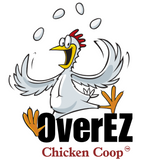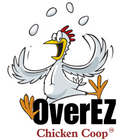Hey there, chicken lovers! Here at OverEZ, we often get asked the question, “What should I put on the floor of my coop?”
When deciding on the best chicken coop bedding for your flock, here are a few things to keep in mind:
- Moisture Control
- Bacteria and Fungal Growth
- Insulation
- Rodent and Insect Control
- Dust Baths and Scratching
- Clean, Healthy Environment
- Clean-Up and Maintenance
So sit down, grab your reading glasses, and get egg-cited because we have provided a list of suitable materials to help inspire you and your coop!
Sand
Sand provides the best moisture control in your coop and facilitates the least amount of bacteria and fungal growth. Sand actually removes moisture from the chicken droppings, leaving your coop fresher, drier, and cleaner than most other materials.
Sand also does a fantastic job at keeping flies, insects, and rodents out of the coop because it does not retain moisture, rot, or decay.
Sand provides great temperature control as well. It keeps your coop warm in the winter and cool in the summer. In cold weather, sand inside the coop will stay dry and dust-bath-ready. In wet climates, the water drains through the sand, eliminating water puddles and material decomposition from happening.
Sand is also great for your chickens! It not only provides your chickens with a fantastic dust bath but is also used as grit in your chicken’s gizzard, which benefits their digestive system. A win-win!
Pros:
✓ Moisture control
✓ Temperature control
✓ Healthy for Chickens
✓ Rodent and Insect Control
✓ Good in Cold and Wet Climates
Cons:
✕ Heavy / harder clean-up
✕ Possible health effects
✕ Not compostable
While sand is an excellent addition to permanent coop floors that sit on the ground, it may not be the best option for removable coop floors due to its heaviness. The heavy nature also makes for a harder, more laborious clean-up.
Although sand is good for your chicken’s gizzard, they may mistakenly eat sand that is mixed in with their droppings. This could possibly lead to health issues, such as E.coli.
Sand cannot be composted in your garden, which is certainly a deal breaker for some.
Note: Be sure to use NATURAL sand. You do not want to use manufactured sand. Manufactured sand is undesirable for dust bathing or chicken litter for that matter.
Straw
Straw seems to be the most popular material used in chicken coops primarily due to its convenience. Most farms have an abundance of straw, so it is a quick and easy way to reuse and repurpose what you already have. However, if you have urban chickens, convenience might not be at play here.
Straw maintains a light and fluffy space and is a much lighter clean-up than sand. Straw provides a nice layer of insulation against the floor, and not to mention chickens love to scratch and play in it.
Pros:
✓ Convenient
✓ Good insulation
✓ Lightweight
✓ Fun for chickens
Cons:
✕ May be dangerous for chickens
✕ Not highly absorbent
✕ Frequent clean up
Straw, especially if it is not chopped, can block your chicken’s digestive route and cause an impacted crop.
Straw is not as absorbent as other materials and does not control moisture very well, which reduces its effectiveness at keeping insects, bacteria, and fungi out.
It can be difficult to clean up due to its clumping and matting nature. It needs to be replaced frequently because it may harbor toxins and odors that can harm your chickens.
Note: Make sure to use chopped straw! Straw that is not chopped can cause crop impaction in your chickens and tends to mat easily when mixed with manure, which holds moisture.
Pine Shavings
Pine shavings fall in the middle of the spectrum between sand and straw. Although not as absorbent as sand, they do a better job at soaking in moisture than straw.
Pine shavings do a decent job at insulating your coop, they are a great low-cost option and a great choice if you use the deep litter method or plan to compost your coop material.
Pine shavings neutralize odor and create a nice smell of pine in your coop. The shavings create a fluffy, fresh, soft look and feel in your coop that many people (and your chickens) love.
Pine shavings are good for both raised coops and coops on the ground. They are lightweight and are easy to transport and store!
Pros:
✓ Moderately dry and absorbent
✓ Good insulation
✓ Low cost
✓ Compostable
✓ Great look and feel
✓ Lightweight
Cons:
✕ May be harmful to chickens
✕ Super dusty
Pine shavings have been reported to be toxic to chickens (especially chicks.) However, the jury is still out on this, so make sure to do your research before choosing this material.
Pine shavings are also incredibly dusty, which is not only a nuisance when it comes to keeping a clean coop, but the dust may also cause respiratory problems for both you and your chickens. We recommend finding “dust-extracted” pine shavings to help with this problem.
Note: Do not use cedar shavings! Cedar shavings give off toxic fumes that can cause asthma and respiratory illness in your chickens. Also, make sure to buy untreated shavings, as the chemicals on treated wood are harmful to your chickens.
Shredded Paper
While shredded paper is not the most common material to use, some chicken lovers resort to it when needed. Shredded paper does the job until you can get regular bedding for your coop. It can also be easily mixed with other types of material to create more bedding in a pinch.
Shredded paper is free! You can find and gather all kinds of recyclable paper, such as newspaper or office paper, to shred, with the only cost being labor!
Shredded paper can definitely be composted, and earthworms love it.
Pros:
✓ Free
✓ Good in a pinch
✓ Mixes easily with other materials
Cons:
✕ Can be toxic to chickens
✕ Not long-lasting
The ink on shredded paper may be toxic for chickens to digest, and office paper tends to be heavily treated and processed.
Paper will not last long in your coop. It is not very absorbent and becomes matted and slick when wet, making for a messy and difficult cleanup.
Organic Matter
Organic matter is the most natural litter choice because it is what you would naturally find outside.
Grass clippings can be used if you have enough, but ensure the grass has not been sprayed with pesticides or other chemicals.
Chickens enjoy almost anything from the garden as well. Weeds, greens, lettuce, clover, and even broccoli will all win you brownie points with your chickens.
Leaves are also an option for your coop. Using leaves on the floor of your coop is free of cost and is a big money saver, especially for larger coops. Chickens enjoy playing and searching in leaves, and there are typically yummy bugs in there for them to eat, too!
Leaves are a great starter for the deep litter method and for your compost.
Pros:
✓ Free
✓ Natural
✓ Compostable
Cons:
✕ Retains moisture
✕ Breaks down quickly
Leaves are not great when wet. They will retain moisture instead of absorbing it, which may lead to mold and odor problems. Leaves also tend to mat when wet, making a slippery surface that can lead to chicken injuries.
Leaves break down more quickly than other materials, so you may have to add or change out the bedding more frequently.
Note: Try not to use a lot of oak leaves. They contain tannins that can harm your chickens if they eat too many.
Hemp Bedding
Hemp bedding has emerged as a superior option compared to traditional materials like straw, wood shavings, and paper. It is an eco-friendly, low-maintenance, and highly effective bedding material for your chicken coop. Many chicken keepers are switching to hemp bedding for its excellent absorbency, odor control, and overall benefits for their flock and the environment.
Pros:
✓ Long-lasting durability
✓ Exceptional Absorbency
✓ Superior Odor Control
✓ Environmentally friendly
✓ Hypoallergenic and dust-free
✓ Easy maintenance
✓ Cost-effective solution
Cons:
✕ May be less readily available
✕ Slightly more expensive initially
Where to Buy Hemp Bedding for Chicken Coops
Hemp bedding is becoming more widely available at farm supply stores and online retailers. Look for products labeled specifically for animal use to ensure they are free of harmful additives.
Can Cat Litter be Used in a Chicken Coop?
While cat litter may seem like a convenient or cost-effective option, it’s important to understand why it’s not suitable for use in a chicken coop.
Cons:
✕ Dust hazards
✕ Clumping and moisture absorption
✕ Toxic ingredients
✕ Ingestion risks
✕ Lack of comfort and insulation
✕ Poor composting qualities
Cat litter works great for its intended purpose, but it is not designed for use in a chicken coop. Choosing an appropriate bedding material ensures the health, comfort, and productivity of your flock. Stick to safe, natural options, and your chickens will thrive in a clean and happy environment.

